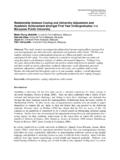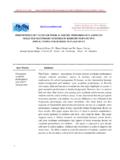Transcription of What are the main risk factors for falls amongst older ...
1 What are the main risk factors for falls amongst older people and what are the most effective interventions to prevent these falls ? March 2004 ABSTRACT This report is HEN s response to a question from a decision-maker. It provides a synthesis of the best available evidence, including a summary of the main findings and policy options related to the issue. Fall prevention programmes can be effective in reducing the number of people who fall andthe rate of falls . Targeted strategies aimed at behavioural change and risk modification for those living in the community appear to be mostpromising.
2 Multifactorial intervention programmes that include risk factor assessment and screening have beenshown to be effective. However, no screening tools have been rigorously validated across countries and furtherwork is needed in this area. HEN, initiated and coordinated by the WHO Regional Office for Europe,is an information service for public health and health care decision-makers in the WHO European Region. Other interested parties might alsobenefit from HEN. This HEN evidence report is a commissioned work and the contents are the responsibility of the authors. Theydo not necessarily reflect the official policies of WHO/Europe.
3 The reports were subjected to international review, managed by the HEN team. When referencing this report, please use the following attribution: Todd C, Skelton D. (2004) What are the main risk factors for falls among older people and what are the most effective interventions to prevent these falls ?Copenhagen, WHO Regional Office for Europe (Health EvidenceNetwork report; , access ed 5 April 2004). Keywords ACCIDENTAL falls ACCIDENT PREVENTION AGED RISK factors EVIDENCE-BASED MEDICINE DECISION SUPPORT TECHNIQUES E UROPE Address requests about publications of the WHO Regional Office to.
4 By e-mail (for copies of publications) (for permission to reproduce them) (for permission to translate them) by post Publications WHO Regional Office for Europe Scherfigsvej 8 DK-2100 Copenhagen , Denmark World Health Organization 2004 All rights reserved.
5 The Regional Office for Europe of the World Health Organization welcomes requests for permission to reproduce or translate its publications, in part or in full. The designations employed and the presentation of the material in this publication do not imply the expression of any opinion whatsoever on the part of the World Health Organization concerning the legal status of any country, territory, city or area or of its authorities, or concerning the delimitation of its frontiers or boundaries. Where the designation country or area appears in the headings of tables, it covers countries, territories, cities, or areas.
6 Dotted lines on maps represent approximate border lines for which there may not yet be full agreement. The mention of specific companies or of certain manufacturers products does not imply that they are endorsed or recommended by the World Health Organization in preference to others of a similar nature that are not mentioned. Errors and omissions excepted, the names of proprietary products are distinguished by initial capital letters. The World Health Organization does not warrant that the information contained in this publication is complete and correct and shall not be liable for any damages incurred as a result of its use.
7 The views expressed by authors or editors do not necessarily represent the decisions or the stated policy of the World Health Organization. 2 What are the main risk factors for falls amongst older people and what are the most effective interventions to prevent these falls ? How should interventions to prevent falls be implemented? March 2004 The Policy Sources for this Incidence of falls and associated Risk Assessment of Prevention of falls and Costs and prevention of Gaps in evidence and conflicting Current debate on populations and strategic Successful multifactorial Recent guidelines and health service Conditions to support successful 3 What are the main risk factors for falls amongst older people and what are the most effective interventions to prevent these falls ?
8 How should interventions to prevent falls be implemented? March 2004 Summary The issue older people make up a large and increasing percentage of the population. As people grow older they are increasingly at risk of falling and consequent injuries. A fall may be the first indication of an undetected illness. The prevention of falls is of major importance because they engender considerable mortality, morbidity and suffering for older people and their families, and incur social costs due to hospital and nursing home admissions. Findings Approximately 30% of people over 65 fall each year, and for those over 75 the rates are higher.
9 Between 20% and 30% of those who fall suffer injuries that reduce mobility and independence and increase the risk of premature death. Fall rates among institution residents are much higher than among community-dwellers. Fall prevention programmes can be effective in reducing the number of people who fall and the rate of falls . Targeted strategies aimed at behavioural change and risk modification for those living in the community appear to be most promising. Multifactorial intervention programmes that include risk factor assessment and screening have been shown to be effective. However, no screening tools have been rigorously validated across countries and further work is needed in this area.
10 The use of physical and pharmacological restraints leads to more severe injuries from falls . Patients with cognitive impairment in hospital after a fall have not benefited from multifactorial interventions, but cognitively impaired residents of care facilities have responded to tailored fall prevention. It seems likely that fall prevention programmes can be cost effective, although more research is required. Policy considerations Unless concerted action is taken, the number of falls is likely to increase over the next 25 to 30 years. A number of interventions targeted to individuals have been shown to work, but population-based strategies have not been properly evaluated.
















